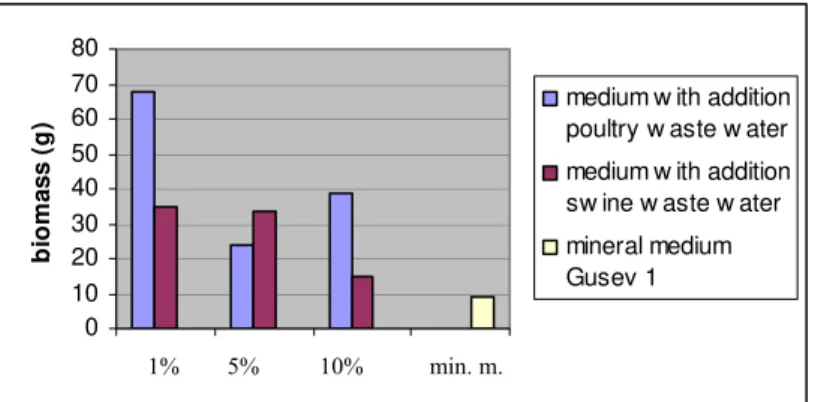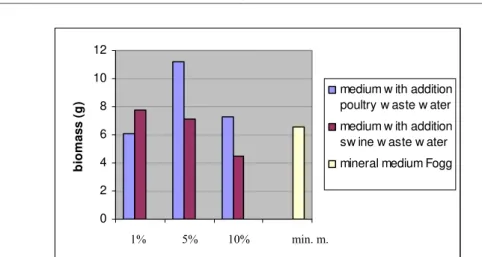MELNICIUC CRISTINA, DONŢU NATALIA, USTUROI RODICA, ŞALARU VICTOR
87 J. Plant Develop.
16 (2009): 87–90
USE OF WASTE WATER OF LIVESTOCK IN ORDER TO OBTAIN
BIOMASS FODDER CHEAP
MELNICIUC CRISTINA1, DONŢU NATALIA1, USTUROI RODICA1,
ŞALARU VICTOR1
Abstract: The aim of this work was the combination of two directions for use of algae: algae biomass obtaining fodder minor and wastewater purification. Subject research have served cianofite species of algae: Nostoc gelatinosum, N. flagelliforme and Anabaena propinqua. As nutrient medium were used wastewater from livestock complexes (poultry and pigs) with a rich content of organic substances. Investigations carried out indicate that the largest quantity of biomass of
Nostoc flageliforme is achieved in the cultivation with wastewater by 1% from pig complexes -13.2 g / l, Nostoc gelatinosum-1% -68 g / l. and Anabaena propinqua-5%-8.8g/l.
Main words: edaphic algae, agrophytocoenoses, ecobiomorphs.
Introduction
One of the difficulties of zootechnics branch which was intense developed in Moldova is insufficient supply of feed resources and biologically active substances that are imported at very high prices. At the same time in ponds and soil of Moldova were discovered over 300 species of algae that have a lot of valuable biochemical contents, have a reproductive capacity of tens and even hundreds times greater than that of plants growing. [ŞALARU, 2001] In addition, biomass of some species are rich in protein, carbohydrates, lipids, etc., which can easily be grown on an industrial scale. But biomass produced on mineral medium is expensive, becoming economically insufficient. Thus arose the need to develop technologies for mass cultivation of some species of algae to use as a nutrient medium wastewater from livestock complex given the fact that biomass produced can be used as a supplement feed for animals that produce the same sewage placed in nutrient medium [GONZÁLEZ & al. 1997; MALLICK, 2002].
Material and methods
The purpose of our research served cianofite algae species Nostoc gelatinosum, N. flagelliforme and Anabaena propinqua. These strains were selected in pure culture from the ground occupied samples crops of wheat and sunflower in Cimishlia district. Cultivation and preservation of pure cultures was performed on solid and liquid mediums: for Nostoc gelatinosum and N. flagelliforme – Gusev 1 and for Anabaena propinqua – Fogg, temperature 25 ºC in laboratory conditions. To achieve the proposed objects we used as a
1
USE OF WASTE WATER OF LIVESTOCK IN ORDER TO OBTAIN BIOMASS FODDER CHEAP
nutrient medium waste water from livestock (poultry and swine) in concentrations of 1%, 5%, and 10%. Algal biomass inoculated was of 4 g.
Results and discussions
Due to the combination of capabilities and autotrophy, the heterotrophic nutrition of these species grow and develop in heavily polluted waters, with a rich content of organic matters. As a result of chemical analysis of these waters was determined that the concentration of NH4 is 118.6 mg/dm3, 0.51 mg/dm3 of NO2, 1.8 mg/dm3 of NO3, and 4 mg/dm3 of PO4 in waters from poultry complexes, and the waste waters from pig complexes has 26.3 mg/dm3 concentration of NH4, 0.03 mg/dm3 of NO2, 1.1 mg/dm3 of NO3, and 67. 5 mg/dm3 of PO4.
Investigations shows that in all experimental variants algae grow and develop, but with some differences, probably given the physiological and concentration of biogenic substances. The best developed strain of Nostoc gelatinosum, was in the average variable addition waste waters with 1% concentration, resulting in the largest amount on medium of poultry-waste waters and of 68.04 g in the pig-waste waters 34.8 g compared with mineral medium Gusev (3.28 g) (Fig. 1). So the environment obtained on addition with 1% poultry manure is the most cost-effective.
0 10 20 30 40 50 60 70 80
1 2 3 4
b
io
m
ass (
g
) medium w ith additionpoultry w aste w ater
medium w ith addition sw ine w aste w ater
mineral medium Gusev 1
Fig. 1 Biomass algae Nostoc gelatinosum, grown on average by addition of waste waters from livestock complexes for 20 days (g / l).
1% 5% 10% min. m.
Increase of algae biomass to mineral medium is observed with experimental variant strain of Anabaena propinqua, resulting in a double quantity. Thus, the option of 5% of waste waters from poultry complexes algal biomass was 8.899 g and the lowest increase is observed in the 1% (Fig. 2).
If we were to compare the development of the two types of environment, then the best environment is to increase addition of manure poultry. The experiments carried out with involvement of the algae strain Nostoc flagelliforme shows that the algae grows mostly on these types of environments (Fig. 3).
MELNICIUC CRISTINA, DONŢU NATALIA, USTUROI RODICA, ŞALARU VICTOR
89
As we see in figure 3 the amount of algal biomass of Nostoc flagelliforme summarized in environments addition of waste waters is higher in comparison with nutrient media (8.068 g). 13.2 g is the mass of the largest amount of algal biomass obtained in the cultivation environment on addition of manure poultry diluted 10 times. So the optimal environment for growing algae may be proposed at the water with addition of pigs waste.
0 2 4 6 8 10 12
1 2 3 4
b
io
m
ass (
g
) medium w ith additionpoultry w aste w ater
medium w ith addition sw ine w aste w ater
mineral medium Fogg
1% 5% 10% min. m.
Fig. 2 Biomass algae Anabaena propinqua grown on average by addition of waste waters from livestock complexes for 20 days (g / l)
0 2 4 6 8 10 12 14
1 2 3 4
b
io
m
ass (
g
) medium with additionpoultry waste water"
medium with addition swine waste water mineral medium Gusev1
1% 5% 10% min.
USE OF WASTE WATER OF LIVESTOCK IN ORDER TO OBTAIN BIOMASS FODDER CHEAP
90
Conclusion
As a result, there could be use the wastewater as a nutrient medium for algae growth matrix in order to obtain a quantity of algal biomass with high content of proteins, carbohydrates and fats. Biochemical contents of these algae did not differ significantly from those grown on nutrient medium. Research data confirm that algae Nostoc gelatinosum, N. flagelliforme and Anabaena propinqua can be used to develop methods of treatment waste water and to obtain algae biomass, which can be used as a source forage for animals with great economic efficiency. Replacement of the mineral medium with addition of manure causes algal biomass have a smaller sinecost.
References
1. ŞALARU V. 2001. Algele edafice din fitocenozele Republicii Moldova. Analele Şti., Univ. de Stat din Moldova: 162-168.
2. GONZÁLEZ, L., CAÑIZARESB R. & BAENA. S. 1997. Efficiency of ammonia and phosphorus removal from a colombian agroindustrial wastewater by the microalgae Chlorella vulgaris and Scenedesmus dimorphus. J. Bioresource Technology,60: 259-262.

